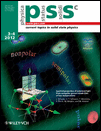Normally-off AlGaN/GaN MOSHFET using ALD SiO2 tunnel dielectric and ALD HfO2 charge storage layer for power device application
Abstract
In this work, we have demonstrated a normally-off AlGaN/GaN metal-oxide semiconductor heterojunction field effect transistor (MOSHFET) wherein the enhancement mode operation is enabled by charge storage characteristics within a high-k layer. By combining ALD SiO2 tunnel dielectric and HfO2 charge trapping layer, up to 7 V of threshold voltage (VT) shift depending on the applied gate pulse amplitude (corresponding ∼ 1.2 × 1013 charges/cm2 stored within the charge storage layer) is obtained. Electrical characteristics such as gate leakage current, transconductance, and off-state breakdown after programming are similar to the initial device. Retention characteristics show about 20% of charge loss after 20000 s. (© 2012 WILEY-VCH Verlag GmbH & Co. KGaA, Weinheim)




